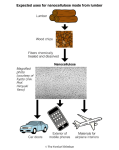100 Japanese firms work together to produce nanocellulose from wood fibers
- Listed: 06/28/2014 5:20 pm
- Expires: This ad has expired
100 firms work together to produce nanocellulose
Date: Jun 29, 2014
Source: The Japan Times
About 100 companies in Japan will work together to put nanocellulose, made from wood fibers, into practical use as a next-generation material, with one-fifth the weight of steel but about five times the strength.
Companies involved with its development include paper manufacturers, automakers, chemical companies and others. They aim to utilize the new material for manufacturing auto parts, construction materials, artificial blood vessels and various other purposes.
Because nanocellulose is made mainly from wood chips, it is considered friendly to the environment. Thus, the government plans to support the development as part of its economic growth strategy.
Expected uses for nanocellulose made from lumber
Nanocellulose is made by chemically processing fibers contained in wood. The fibers are dissolved into pieces, each of which is measured on a nanometer scale. One nanometer is one-millionth of a meter and is about one-hundred-thousandths of the thickness of a human hair.
Besides being light and strong, nanocellulose is resistant to deformation by heat.
Because the material is made from plants, experts believe that its production will have less of a negative impact on the environment. And as nanocellulose is combined with other materials when it is used to make products, there is no fear that the material will rot even if it gets wet.
The main merit of nanocellulose is that it can be made efficiently from materials that have until now been underutilized, such as timber from forest thinning and rice straw.
Nanocellulose is as light and strong as carbon fibers, which are used to manufacture aircraft bodies and have contributed to improvements in fuel efficiency.
Carbon fibers are made mainly from petroleum, but because nanocellulose is made from wood, Japan has a resource advantage with its abundant forests.
Paper manufacturers, which produce paper products by extracting fibers from timber and other raw materials, are using the technology to develop nanocellulose materials. Some of them, including Nippon Paper Industries Co., have started production of the material on a test basis.
If the range of usage widens, mass-production will be possible. Thus, the government expects that the price level of nanocellulose in 2030 will be ¥500 per kilogram or lower, which is about one-tenth of the current level.
The government has set goals of making nanocellulose a material that can compete with carbon fiber in terms of pricing, and of expanding the size of the market for the new material along with related businesses to the value of ¥1 trillion in 2030.






